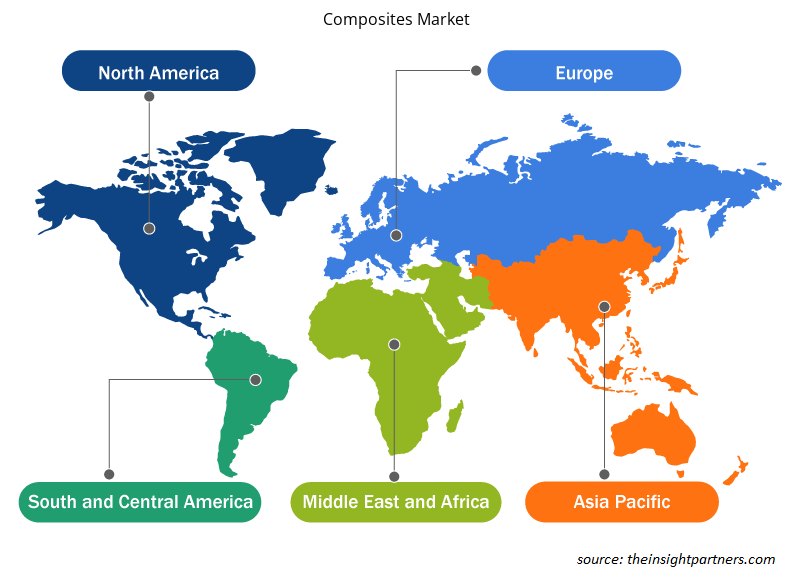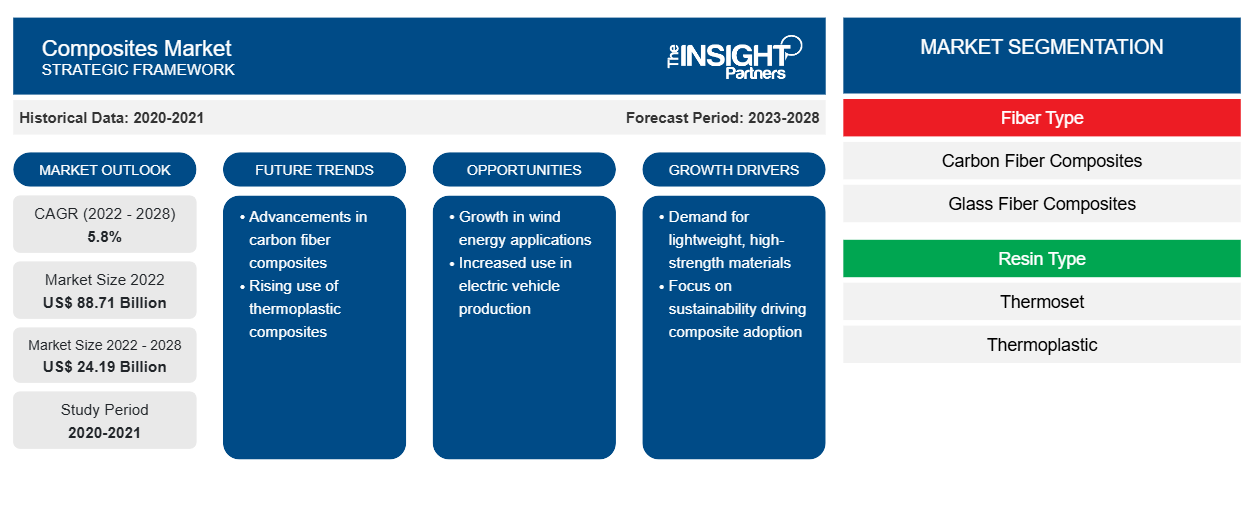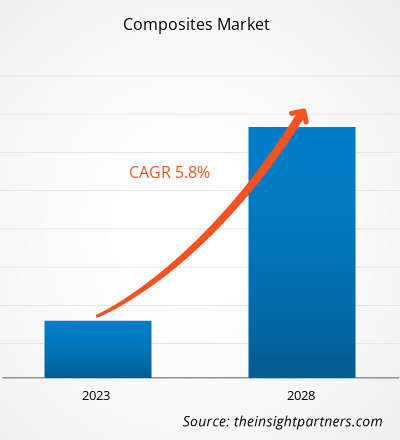复合材料市场规模预计将从 2022 年的 887.1042 亿美元增长到 2028 年的 1241.8535 亿美元;预计 2022 年至 2028 年的复合年增长率为 5.8%。
与大多数木材和金属相比,复合材料重量轻。复合材料的轻质特性使其在汽车和飞机中具有重要应用,因为重量越轻,燃油效率越高。如今,飞机设计师非常关注重量,因为减轻飞机重量可以减少所需的燃油量并提高飞机的速度。此外,复合材料可以抵抗天气和刺激性化学物质的损害。与大多数其他材料相比,它们可以更容易地模制成复杂的形状。
2022 年,亚太地区占据全球复合材料市场的最大收入份额。由于复合材料在汽车、风能、建筑、体育用品等各种终端行业中的使用日益广泛,亚太地区对复合材料的需求正在增加。不断发展的建筑业是该地区复合材料市场增长的重要贡献者。亚太地区正在经历城市化,住宅和商业项目建设不断增加。此外,该地区的人均收入有所增加,再加上经济适用房的发展。这导致亚太地区城市化进程迅速。该地区多个国家与住宅物业开发相关的优惠政府政策推动了城市化进程。此外,中国和印度等国家是世界上风电装机容量排名前五的国家。所有这些因素都为该地区复合材料市场的增长做出了积极贡献。
定制此报告以满足您的需求
您可以免费定制任何报告,包括本报告的部分内容、国家级分析、Excel 数据包,以及为初创企业和大学提供优惠和折扣
- 获取此报告的关键市场趋势。这个免费样品将包括数据分析,从市场趋势到估计和预测。
COVID-19 疫情对复合材料市场的影响
汽车、航空航天、建筑、船舶和能源等行业是复合材料需求的主要贡献者。2020 年,由于国家和国际边界关闭导致价值链中断,这些行业不得不放慢运营速度。人力短缺导致复合材料生产和分销业务减速。全球供应链中断和树脂生产设施关闭导致复合材料价格大幅飙升。2020 年,不同国家实施的封锁阻碍了行业维持库存水平的能力。此外,卫生措施和其他 COVID-19 预防措施大大降低了生产能力,导致复合材料库存短缺。然而,随着各国政府宣布放宽社会限制,2021 年全球市场开始从 2020 年的损失中恢复过来。此外,疫苗接种率的提高有助于改善不同国家的整体状况,从而为工业和商业发展创造了有利的环境。根据世界经济论坛,COVID-19 疫情有可能带来家居设计的创新,并有望为房屋装修领域提供新的机会。预计这一因素将在预测期内为复合材料市场的增长提供丰厚的机会。
市场洞察
汽车和航空航天工业对轻质材料的需求不断增加
汽车制造商在确保安全性和性能的同时,更倾向于使用轻质材料来制造汽车。轻质材料在提高燃油效率方面具有巨大的潜力。汽车重量减轻 10% 可使燃油经济性提高 6-8%。碳纤维复合材料等先进材料有可能将汽车部件的重量减轻 50-75%。复合材料在汽车领域的应用持续增长。与不可再生来源的复合材料相比,塑料复合材料具有出色的声学和热学性能,使其成为汽车内饰部件的理想选择。此外,它们还适用于制造非结构性内饰部件,包括座椅填充物、座椅靠背、车顶内衬、内饰板和仪表板。此外,飞机制造商正在努力扩大公务机和商用飞机的主要热塑性结构。他们是长纤维增强热塑性塑料的早期采用者。
光纤类型洞察
根据纤维类型,全球复合材料市场细分为碳纤维复合材料、玻璃纤维复合材料等。2022 年,玻璃纤维复合材料领域的全球复合材料市场份额最大。玻璃纤维复合材料采用各种制造技术生产,用途广泛。玻璃纤维具有多种特性,即高强度、柔韧性、耐用性和抗化学损伤性。它可以是粗纱、短切丝、纱线、织物和垫子的形式。每种类型的玻璃纤维都有不同的特性,并以聚合物复合材料的形式用于各种应用。玻璃纤维复合材料因其良好的特性而成为工业应用的首选,例如高强度重量比、良好的尺寸稳定性、良好的耐热性和耐腐蚀性、良好的电绝缘性能、易于制造和相对较低的成本。
全球复合材料市场的主要参与者包括杜邦公司、固瑞特控股公司、瀚森公司、三菱化学控股公司、日本电气硝子株式会社、欧文斯科宁公司、西格里碳素公司、帝人公司、索尔维公司和东丽工业公司。全球复合材料市场的参与者专注于提供高质量的产品以满足客户需求。他们还专注于投资研发活动和新产品发布等战略。
报告亮点
- 复合材料市场的渐进式行业趋势可帮助参与者制定有效的长期战略
- 发达市场和发展中市场采用的业务增长战略
- 2020 年至 2028 年复合材料市场的定量分析
- 全球复合材料需求量估计
- 波特五力分析说明了行业内买家和供应商的效力
- 了解竞争市场状况的最新发展
- 市场趋势和前景,以及推动和抑制复合材料市场增长的因素
- 通过强调支撑商业利益的市场策略来协助决策过程,从而促进市场增长
- 不同节点的复合材料市场规模
- 市场的详细概述和细分,以及复合材料行业动态
- 各地区复合材料市场规模及增长机遇
复合材料市场区域洞察
Insight Partners 的分析师已详尽解释了预测期内影响复合材料市场的区域趋势和因素。本节还讨论了北美、欧洲、亚太地区、中东和非洲以及南美和中美洲的复合材料市场细分和地理位置。

- 获取复合材料市场的区域特定数据
复合材料市场报告范围
| 报告属性 | 细节 |
|---|---|
| 2022 年市场规模 | 887.1亿美元 |
| 2028 年市场规模 | 241.9亿美元 |
| 全球复合年增长率(2022 - 2028) | 5.8% |
| 史料 | 2020-2021 |
| 预测期 | 2023-2028 |
| 涵盖的领域 | 按纤维类型
|
| 覆盖地区和国家 | 北美
|
| 市场领导者和主要公司简介 |
|
复合材料市场参与者密度:了解其对业务动态的影响
复合材料市场正在快速增长,这得益于最终用户需求的不断增长,而这些需求又源于消费者偏好的不断变化、技术进步以及对产品优势的认识不断提高等因素。随着需求的增加,企业正在扩大其产品范围,进行创新以满足消费者的需求,并利用新兴趋势,从而进一步推动市场增长。
市场参与者密度是指在特定市场或行业内运营的企业或公司的分布情况。它表明在给定市场空间中,相对于其规模或总市场价值,有多少竞争对手(市场参与者)存在。
在复合材料市场运营的主要公司有:
- 杜邦公司
- 固瑞特控股公司
- 瀚森公司
- 三菱化学控股公司
- 日本电气硝子株式会社
免责声明:上面列出的公司没有按照任何特定顺序排列。

- 了解复合材料市场的主要参与者概况
全球复合材料市场
根据纤维类型,全球复合材料市场细分为碳纤维复合材料、玻璃纤维复合材料和其他。根据树脂类型,全球复合材料市场分为热固性材料和热塑性材料。热固性材料细分为聚酯、乙烯基酯、环氧树脂、聚氨酯和其他。热塑性材料细分为聚丙烯、聚乙烯、聚氯乙烯、聚苯乙烯、聚对苯二甲酸乙二醇酯、聚碳酸酯和其他。根据最终用途行业,全球复合材料市场细分为汽车、航空航天和国防、风能、建筑、船舶、体育用品和其他。
公司简介
- 杜邦公司
- 固瑞特控股公司
- 瀚森公司
- 三菱化学控股公司
- 日本电气硝子株式会社
- 欧文斯科宁
- SGL 碳素公司
- 帝人株式会社
- 索尔维公司
- 东丽株式会社
- 历史分析(2 年)、基准年、预测(7 年)及复合年增长率
- PEST 和 SWOT 分析
- 市场规模价值/数量 - 全球、区域、国家
- 行业和竞争格局
- Excel 数据集



Report Coverage
Revenue forecast, Company Analysis, Industry landscape, Growth factors, and Trends

Segment Covered
This text is related
to segments covered.

Regional Scope
North America, Europe, Asia Pacific, Middle East & Africa, South & Central America

Country Scope
This text is related
to country scope.
常见问题
The increasing demand for lightweight materials from automotive & aerospace industry, and rising utilization of glass-fiber composites in end-use industries, are some of the key driving factors for the composites market.
Based on end-use industry, wind energy is the fastest-growing segment. The rising adoption of composites in renewable energy due to properties such as lightweight, and lower maintenance costs, is driving the segment’s growth. At present, research and development is highly focused towards innovative materials aimed to satisfy turbine requirements such as increased size turbine and rotor blades for land-based and off-shore systems.
The applications of composites in wind energy sector, is expected to provide lucrative growth opportunities to the global composites market during the forecast period.
Asia Pacific composites market is driven by growth in end-use industries such as wind power, electronics, and automotive industries, which is expected to create favorable business opportunities for the composites market during the forecast period. Therefore, Asia Pacific accounts for the largest share of the global composites market.
The major players operating in the global composites market are Mitsubishi Chemical Holdings Corp; Nippon Electric Glass Co Ltd; Solvay SA; Toray Industries Inc; DuPont de Nemours Inc; amongst others.
Glass fiber composite materials are highly preferred for industrial applications due to their favorable characteristics such as high strength-to-weight ratio, good dimensional stability, good resistance to heat and corrosion, good electrical insulation properties, ease of fabrication, and relatively low cost. Therefore, this factor is expected to boost the glass fiber composites segment’s share.
Trends and growth analysis reports related to Chemicals and Materials : READ MORE..
The List of Companies - Composites Market
- DuPont de Nemours Inc
- Gurit Holding AG
- Hexion Inc
- Mitsubishi Chemical Holdings Corp
- Nippon Electric Glass Co Ltd
- Owens Corning
- SGL Carbon SE
- Teijin Ltd
- Solvay SA
- Toray Industries Inc
The Insight Partners performs research in 4 major stages: Data Collection & Secondary Research, Primary Research, Data Analysis and Data Triangulation & Final Review.
- Data Collection and Secondary Research:
As a market research and consulting firm operating from a decade, we have published and advised several client across the globe. First step for any study will start with an assessment of currently available data and insights from existing reports. Further, historical and current market information is collected from Investor Presentations, Annual Reports, SEC Filings, etc., and other information related to company’s performance and market positioning are gathered from Paid Databases (Factiva, Hoovers, and Reuters) and various other publications available in public domain.
Several associations trade associates, technical forums, institutes, societies and organization are accessed to gain technical as well as market related insights through their publications such as research papers, blogs and press releases related to the studies are referred to get cues about the market. Further, white papers, journals, magazines, and other news articles published in last 3 years are scrutinized and analyzed to understand the current market trends.
- Primary Research:
The primarily interview analysis comprise of data obtained from industry participants interview and answers to survey questions gathered by in-house primary team.
For primary research, interviews are conducted with industry experts/CEOs/Marketing Managers/VPs/Subject Matter Experts from both demand and supply side to get a 360-degree view of the market. The primary team conducts several interviews based on the complexity of the markets to understand the various market trends and dynamics which makes research more credible and precise.
A typical research interview fulfils the following functions:
- Provides first-hand information on the market size, market trends, growth trends, competitive landscape, and outlook
- Validates and strengthens in-house secondary research findings
- Develops the analysis team’s expertise and market understanding
Primary research involves email interactions and telephone interviews for each market, category, segment, and sub-segment across geographies. The participants who typically take part in such a process include, but are not limited to:
- Industry participants: VPs, business development managers, market intelligence managers and national sales managers
- Outside experts: Valuation experts, research analysts and key opinion leaders specializing in the electronics and semiconductor industry.
Below is the breakup of our primary respondents by company, designation, and region:

Once we receive the confirmation from primary research sources or primary respondents, we finalize the base year market estimation and forecast the data as per the macroeconomic and microeconomic factors assessed during data collection.
- Data Analysis:
Once data is validated through both secondary as well as primary respondents, we finalize the market estimations by hypothesis formulation and factor analysis at regional and country level.
- Macro-Economic Factor Analysis:
We analyse macroeconomic indicators such the gross domestic product (GDP), increase in the demand for goods and services across industries, technological advancement, regional economic growth, governmental policies, the influence of COVID-19, PEST analysis, and other aspects. This analysis aids in setting benchmarks for various nations/regions and approximating market splits. Additionally, the general trend of the aforementioned components aid in determining the market's development possibilities.
- Country Level Data:
Various factors that are especially aligned to the country are taken into account to determine the market size for a certain area and country, including the presence of vendors, such as headquarters and offices, the country's GDP, demand patterns, and industry growth. To comprehend the market dynamics for the nation, a number of growth variables, inhibitors, application areas, and current market trends are researched. The aforementioned elements aid in determining the country's overall market's growth potential.
- Company Profile:
The “Table of Contents” is formulated by listing and analyzing more than 25 - 30 companies operating in the market ecosystem across geographies. However, we profile only 10 companies as a standard practice in our syndicate reports. These 10 companies comprise leading, emerging, and regional players. Nonetheless, our analysis is not restricted to the 10 listed companies, we also analyze other companies present in the market to develop a holistic view and understand the prevailing trends. The “Company Profiles” section in the report covers key facts, business description, products & services, financial information, SWOT analysis, and key developments. The financial information presented is extracted from the annual reports and official documents of the publicly listed companies. Upon collecting the information for the sections of respective companies, we verify them via various primary sources and then compile the data in respective company profiles. The company level information helps us in deriving the base number as well as in forecasting the market size.
- Developing Base Number:
Aggregation of sales statistics (2020-2022) and macro-economic factor, and other secondary and primary research insights are utilized to arrive at base number and related market shares for 2022. The data gaps are identified in this step and relevant market data is analyzed, collected from paid primary interviews or databases. On finalizing the base year market size, forecasts are developed on the basis of macro-economic, industry and market growth factors and company level analysis.
- Data Triangulation and Final Review:
The market findings and base year market size calculations are validated from supply as well as demand side. Demand side validations are based on macro-economic factor analysis and benchmarks for respective regions and countries. In case of supply side validations, revenues of major companies are estimated (in case not available) based on industry benchmark, approximate number of employees, product portfolio, and primary interviews revenues are gathered. Further revenue from target product/service segment is assessed to avoid overshooting of market statistics. In case of heavy deviations between supply and demand side values, all thes steps are repeated to achieve synchronization.
We follow an iterative model, wherein we share our research findings with Subject Matter Experts (SME’s) and Key Opinion Leaders (KOLs) until consensus view of the market is not formulated – this model negates any drastic deviation in the opinions of experts. Only validated and universally acceptable research findings are quoted in our reports.
We have important check points that we use to validate our research findings – which we call – data triangulation, where we validate the information, we generate from secondary sources with primary interviews and then we re-validate with our internal data bases and Subject matter experts. This comprehensive model enables us to deliver high quality, reliable data in shortest possible time.


 获取此报告的免费样本
获取此报告的免费样本